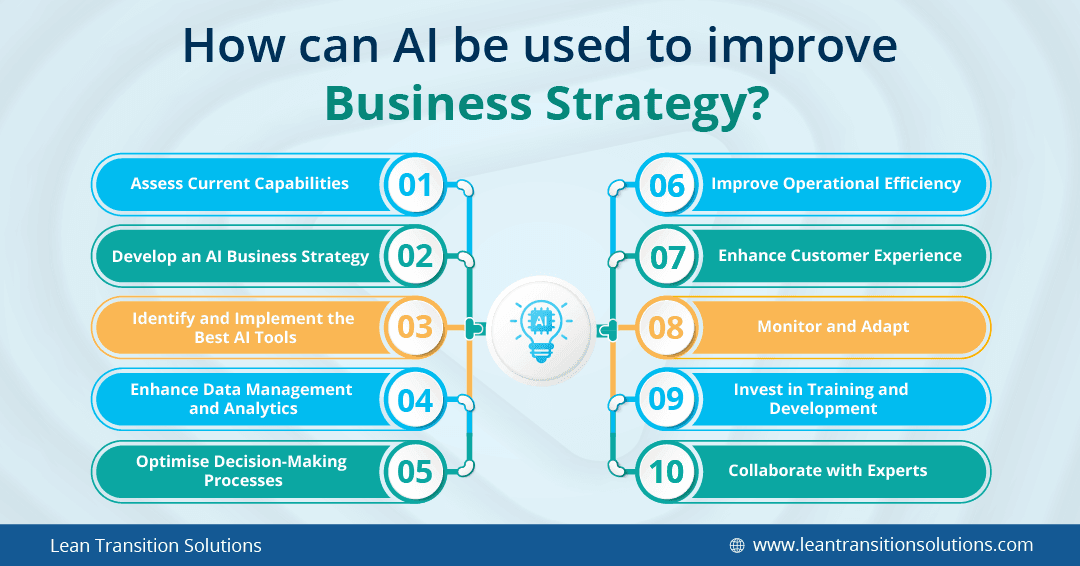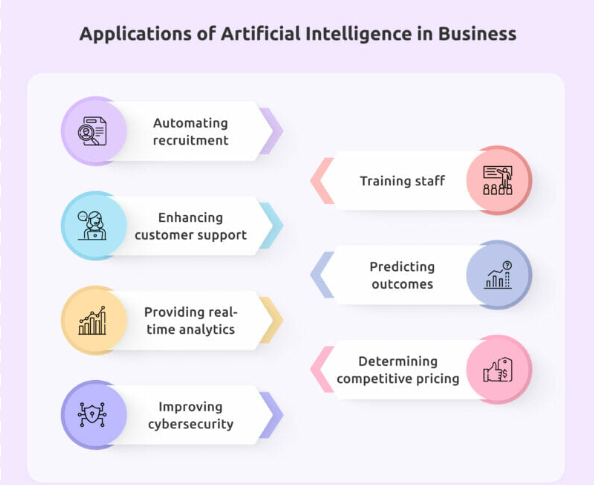The role of Business Efficiency with AI in enhancing internal communication
Enhancing Company Efficiency With AI: the Duty of Conversational AI in Modern Workflow
In today's busy business landscape, organizations are progressively turning to AI to enhance effectiveness (Business Efficiency with AI). Conversational AI stands out as an essential tool, automating client communications and improving interior interactions. By streamlining these processes, organizations can increase and reduce expenses decision-making. Nevertheless, truth potential of conversational AI extends past plain automation. What specific advantages does it give contemporary operations, and exactly how can business successfully apply it to drive development?
Understanding Conversational AI and Its Abilities
As services progressively look for cutting-edge remedies to boost efficiency, understanding conversational AI becomes vital. This innovation leverages all-natural language handling and device understanding to help with human-like communications with customers. By interpreting and responding to inquiries, conversational AI can improve process and offer important insights right into client preferences and habits.
The abilities of conversational AI extend beyond basic conversation capabilities. It can take care of intricate inquiries, preserve context over discussions, and adjust to private user needs, thereby developing a tailored experience. In addition, its combination with different platforms enables seamless interaction across channels, making certain that organizations stay available to their customers.
Furthermore, conversational AI systems can assess large amounts of information to determine trends, which can notify tactical decision-making. This not only improves operational performance but additionally supports innovation by making it possible for services to react quickly to market changes and client demands.
Automating Client Communications for Improved Fulfillment
While companies intend to improve client contentment, automating client communications has become a key method. By leveraging conversational AI, companies can improve feedbacks to customer questions, guaranteeing prompt and accurate info distribution. This technology permits 24/7 schedule, which greatly minimizes wait times and enhances accessibility for clients.
In addition, automation can deal with repeated jobs, such as order monitoring and frequently asked questions, maximizing human agents to concentrate on more complicated problems. This not just boosts functional performance yet likewise causes an extra tailored consumer experience, as automated systems can assess previous communications to customize feedbacks.
The execution of chatbots and digital aides aids to keep a constant brand voice while collecting beneficial information for future enhancements. Eventually, automating client interactions fosters higher contentment levels, as clients value much faster resolutions and seamless interaction, strengthening their commitment to the brand name.
Enhancing Interior Interaction Across Teams
Efficient inner interaction is essential for a firm's success, and AI modern technologies can greatly boost this facet. By simplifying information sharing and providing real-time cooperation devices, groups can work more successfully and stay engaged. This makeover results in improved cooperation and a much more cohesive work setting.
Streamlined Info Sharing
They can greatly boost interior interaction across groups when organizations apply AI-driven tools for details sharing. These devices promote the seamless exchange of details, making sure that workers have access to relevant data at their fingertips. By leveraging conversational AI, companies can enhance questions and actions, reducing the moment spent browsing for details. This not only reduces miscommunication yet also promotes a culture of cooperation, as teams can swiftly straighten on projects and share understandings. In addition, AI tools can categorize and focus on details, making it simpler for staff members to locate vital resources. Because of this, interior interaction comes to be extra effective, encouraging teams to concentrate on tactical jobs rather than getting slowed down by information overload.
Real-Time Partnership Devices
Structure on the foundation of streamlined information sharing, real-time partnership tools play a crucial role in enhancing internal communication across teams. These devices promote instant exchanges of concepts, making it possible for groups to function together efficiently regardless of geographical barriers. By integrating functions such as immediate messaging, video clip conferencing, and collaborative file modifying, organizations promote a society of transparency and responsiveness. Furthermore, these tools enable the seamless integration of synthetic intelligence, which can automate task assignments and offer immediate comments, thus improving productivity. With real-time collaboration, staff members can resolve concerns as they develop, decreasing misconceptions and hold-ups. Eventually, the implementation of such devices grows a much more cohesive workplace, vital for driving projects onward successfully.
Boosted Team Engagement
Enhancing team interaction is vital for fostering a determined labor force, as it directly affects productivity and spirits within an organization. Conversational AI plays a crucial function in boosting interior interaction across groups by assisting in seamless interactions. Via chatbots and online aides, employees can promptly access information, share updates, and give comments without the hold-ups related to traditional communication methods. This modern technology motivates cooperation by breaking down silos, allowing cross-departmental discussion, and making sure every person remains straightened with organizational objectives. Furthermore, customized AI-driven understandings can help determine involvement levels, allowing administration to resolve issues proactively. Ultimately, enhanced team interaction via conversational AI not just strengthens connections among workers yet additionally drives overall company effectiveness.
Increasing Decision-Making Procedures
Fabricated Knowledge (AI) substantially streamlines decision-making processes across various company sectors. By making use of sophisticated algorithms and information analytics, AI enables organizations to analyze large amounts of information quickly and precisely. This ability enables services to determine patterns and insights that might or else continue to be undetected, promoting even more educated options.
Conversational AI, in particular, plays an essential function in enhancing these processes by making it possible for real-time interaction and info retrieval. Workers can engage with AI systems to posture inquiries and get immediate feedback, reducing the moment invested in research and consideration. Furthermore, AI assists in evaluating numerous situations and offering anticipating understandings, which even more increases the decision-making timeline.
Ultimately, the combination of AI technologies cultivates a culture of agility and responsiveness within firms, equipping leaders to make timely choices that line up with dynamic market conditions. This transformative influence on decision-making emphasizes the value of AI in modern functional strategies.
Lowering Operational Prices With AI Combination
AI integration plays an essential duty in decreasing functional costs by enhancing processes and automating regular tasks. This modern technology improves source allotment performance, allowing organizations to optimize their workforce and products effectively. Therefore, companies can accomplish substantial cost savings while keeping productivity levels.
Structured Procedures and Automation
As businesses progressively look for ways to lessen functional prices, the combination of intelligent automation modern technologies has actually become a pivotal remedy. This method streamlines processes by automating repetitive jobs, thereby minimizing the demand for manual treatment. By employing conversational AI, organizations can improve consumer engagement while ensuring reliable handling of questions, which causes quicker resolutions and raised satisfaction. Additionally, automating operations reduces errors and accelerates action times, permitting teams to concentrate on calculated efforts as opposed to regular procedures. The result is a much more active company environment where resources are utilized better. The assimilation of AI not only assists in reducing prices however likewise cultivates innovation through the reallocation of human skill to even more value-added activities.
Improved Source Allocation Efficiency
Effective source appropriation stands as a keystone for lowering functional costs in contemporary services. By leveraging expert system, companies can analyze data patterns and anticipate resource requires more accurately. Conversational AI plays a pivotal role in this procedure, making it possible for real-time communication and decision-making. It can automate scheduling, handle supply, and enhance labor force implementation, making sure that sources are made use of efficiently. This not just decreases waste but also enhances performance. Additionally, AI-driven insights allow services to identify locations of over-expenditure and enhance procedures appropriately. As companies accept AI assimilation, they experience substantial expense reductions while enhancing general operational performance. Eventually, enhanced source allowance via AI positions companies to prosper in significantly open markets.
Leveraging Data Insights for Strategic Preparation
Just how can organizations harness information understandings to inform their critical preparation? By utilizing data-driven methodologies and advanced analytics, companies can obtain important insights that directly affect their tactical choices. Conversational AI devices play a significant role in this process by collecting and assessing vast quantities of information from client interactions, market fads, and operational metrics.
These understandings make it possible for organizations to recognize emerging possibilities and possible threats, allowing for notified decision-making. Furthermore, predictive analytics powered by AI can forecast future trends, aiding in the formula of positive approaches. By leveraging real-time data, firms can adapt their approaches swiftly to straighten with market characteristics.

Instance Studies: Successful Implementation of Conversational AI
Organizations progressively acknowledge the worth of conversational AI in boosting operational efficiency and customer engagement. A noteworthy situation is that of a leading retail business that carried out a chatbot to manage customer questions. This reduced feedback times by 60%, permitting human representatives to concentrate on complicated problems, eventually raising client complete satisfaction ratings.
In an additional instance, a financial solutions strong incorporated conversational AI right into its customer support operations, causing a 30% reduction in call quantity. The AI system effectively managed regular questions, liberating personnel for higher-level tasks and boosting general service quality.
Additionally, a healthcare service provider utilized conversational AI for consultation organizing and client follow-ups. This initiative structured operations, leading to a 40% rise in consultation bookings and boosted person involvement.
These study illustrate how companies can leverage conversational AI to maximize processes, boost client experiences, and achieve substantial operational end results.
Often Asked Concerns

How Do I Choose the Right Conversational AI Platform for My Business?
To pick the right conversational AI system, one need to assess business needs, evaluate scalability, take into consideration assimilation capabilities, compare rates models, examine user reviews, and prioritize platforms offering durable assistance and personalization choices tailored to details needs.
What Are the Typical Difficulties in Executing Conversational AI?
Common obstacles in carrying out conversational AI include integration with existing systems, ensuring all-natural language understanding, managing customer assumptions, dealing with information privacy concerns, and safeguarding ample training and assistance for both staff members and individuals. - Business Efficiency with AI
Exactly How Can I Measure the Success of Conversational AI Initiatives?
Success of conversational AI efforts can be measured via metrics such as individual involvement, action accuracy, client complete satisfaction ratings, cost savings, and total effect on functional efficiency, over here giving an extensive view of efficiency and renovation areas.
What Industries Advantage one of the most From Conversational AI Solutions?
Industries such as retail, consumer, finance, and health care solution experience substantial benefits from conversational AI options. These sectors take advantage of AI to boost consumer interactions, simplify operations, and improve general performance, inevitably driving greater fulfillment and involvement.
Just How Does Conversational AI Incorporate With Existing Software Systems?
Conversational AI integrates effortlessly with existing software program systems by making use of APIs, enabling data exchange and enhancing user experiences. This interoperability enables organizations to enhance operations and boost interaction throughout various systems, cultivating better functional performance.
Conversational AI stands out as a critical tool, automating consumer communications and enhancing internal interactions. As services significantly look for cutting-edge remedies to boost performance, recognizing conversational AI comes to be crucial. Conversational AI, in certain, plays a crucial duty in improving these processes by enabling real-time communication and details access. Organizations progressively acknowledge the value of conversational AI in boosting functional effectiveness and customer involvement. Conversational AI incorporates effortlessly with existing software application systems by utilizing APIs, making it possible for information exchange and improving user experiences.